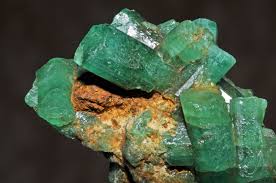EMERALD: THE ALLURE OF THE EVERGREEN STONE

Some historians estimate that the Egyptians mined emeralds as early as 3500 BC. Although some say the ancient Romans (circa 500 BC to 400 AD ) knew of emerald mines in the European Alps, Egypt was the major source of emeralds until the sixteenth century when Spanish explorers discovered abundant mines in South America. Colombia is still considered today one of the most important sources for emeralds.
The emerald is a variety of beryl, a class that includes various stones differentiated by colour: the cool blue variety is the well-known Aquamarine, Morganite has a delicate pastel pink to peach quality, Heliodor is an attractive yellow variety, and there is also a dark blue beryl called Maxixe (not used in jewellery because its colour fades away rapidly if it is exposed to light and heat), and a red beryl that some dealers market as “red emerald”. Emeralds are, above all, appreciated for their color: the emerald
has been the standard for green among colored stones for thousands of years. The most desirable colours range from bluish green to green, with strong to vivid saturation and medium to medium-dark tone. Slight differences in hue, tone and saturation can make a great difference in emerald value when the other factors (carat weight and clarity) are identical.
Because of the way emeralds form, they are more brittle than other gems like corundum (sapphires and rubies). Emeralds are usually internally fractured and present inclusions usually visible to the unaided eye. These factors make them vulnerable to damage during the cutting process or even during careless everyday wear. An emerald’s fractures are often filled with oil or resin to improve its appearance and increase durability – any treatments must always be disclosed to clients. Inclusions in an emerald don’t necessarily have to be seen as a negative – they help gemologists to separate natural emeralds from synthetic ones, which were first produced in the '30s. Emerald inclusions are often described as looking mossy or garden-like; some people in the trade use the term “jardin”, the French word for garden, to describe them.
Colombia, Zambia, Brazil and Zimbabwe supply the majority of emeralds on the international market. Historically, Colombia is the source that produces the highest quality and highest volume of emeralds. In the trade, “Colombian” is commonly used to describe the finest emerald color. Emeralds were discovered in Zambia in 1931 but there was no production until 1967; these crystals are irregular in shape and the stones are generally darker in tone. Although Brazilian mines occasionally yield fine emerald crystals, they generally yield more commercial-quality stones than the Colombian mines. The Sandawana emerald mine was discovered in 1956, when Zimbabwe was known as Rhodesia, and has been a consistent producer since 1993. The production of this mine is known for its very small yet richly colored stones.
Today, the emerald is the world’s premier green stone. Some very high-quality emeralds can even exceed diamonds in per-carat value. In the October 2018 sale Aste Bolaffi presented a 1880’s ring set with a round-cut Colombian emerald, which, rising from a starting price of 9,000 euros, sold for almost double the estimated value. In our next auction on October 17th we will present an antique 1900’s ring set with a beautiful rectangular step-cut emerald weighing approximately 3.20 ct, opening at 10,000 euros. (by Federica Selleri)
THE UPCOMING FINE JEWELS AUCTION
